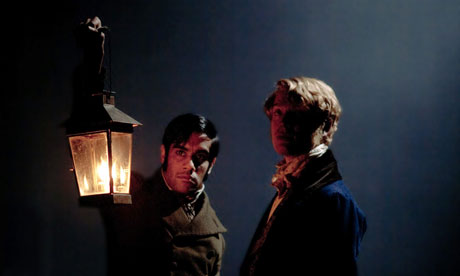Charles Dickens died before he could finish his last novel. So crime-writer Gwyneth Hughes set out to complete it for a new BBC version – and soon wished she hadn't

Drugs, lust and murder … Gwyneth Hughes’s completed version of The Mystery of Edwin Drood. Photograph: Laurence Cendrowicz/BBC
Ever since 1950, when the BBC gave us the live, first-ever broadcast of A Christmas Carol, we've relied on Charles Dickens to see us through the winter months, as we draw the curtains, stoke the fire, and sit down in front of the box with a hankie, ready to weep and chuckle our way back into his vivid, awful, exciting 19th century, when people had wonderful names like Scrooge and Cratchit, and every sentence was longer than this one.
We are now in Dickens Year, it being the 200th anniversary of his birth on 7 February. By way of celebration, the BBC has already given us a new Great Expectations, starring Ray Winstone and Gillian Anderson. And following on from that old favourite, there's an invitation to enter a darker, stranger world, a shadowy place of drug addiction, illicit lust and murder. Gentle reader, welcome to my world.
My pitch to the BBC to complete the author's great unfinished novel was short and sweet: "The Mystery of Edwin Drood. Episode one – by Charles Dickens. Episode two – by moi!" This made some important people laugh and got me the commission. As a humble crime writer, I was thrilled. My first classic adaptation!
It's fairly well known that Dickens died halfway through writing his murky story about an opium-addicted, erotically obsessed choirmaster called John Jasper, who plots to murder his nephew and love rival, Edwin Drood. What's less well known is that Dickens died on purpose – to avoid having to finish it. Or that's what I came to believe, after months of wrestling in darkened rooms with the questions he ran out of time to answer. Who actually kills Edwin Drood? What is the meaning of that strange and awful cry in the night? What brings the prickly and defensive Landless twins all the way back from Ceylon to the sleepy fictional cathedral city of Cloisterham? And is that really a big white wig on Mr Datchery's head?
As always, the writing in Dickens is so magisterially confident that, on first reading, you are absolutely sure the author knew where he was going. After all, in every corner lurk what must surely be expertly placed clues: Jasper's black silk scarf, seemingly full of murderous intent; Mayor Sapsea's tomb and its enormous key; that pile of quicklime crying out, "Notice me!" But the more I studied clues in the text, and others I came across in conversations between Dickens, his friends and his family, the more the whole enterprise rocked like a demented house of cards. Some clues lead nowhere. Some are contradictory. Some just plain wrong. That pile of quicklime? Dickens seems to have believed it dissolved human flesh. Did he intend to pop a dead body into it, one that would later be identified by an undissolved ruby ring? Perhaps – but quicklime actually has a preserving effect.
Full piece at the Guardian.
We are now in Dickens Year, it being the 200th anniversary of his birth on 7 February. By way of celebration, the BBC has already given us a new Great Expectations, starring Ray Winstone and Gillian Anderson. And following on from that old favourite, there's an invitation to enter a darker, stranger world, a shadowy place of drug addiction, illicit lust and murder. Gentle reader, welcome to my world.
My pitch to the BBC to complete the author's great unfinished novel was short and sweet: "The Mystery of Edwin Drood. Episode one – by Charles Dickens. Episode two – by moi!" This made some important people laugh and got me the commission. As a humble crime writer, I was thrilled. My first classic adaptation!
It's fairly well known that Dickens died halfway through writing his murky story about an opium-addicted, erotically obsessed choirmaster called John Jasper, who plots to murder his nephew and love rival, Edwin Drood. What's less well known is that Dickens died on purpose – to avoid having to finish it. Or that's what I came to believe, after months of wrestling in darkened rooms with the questions he ran out of time to answer. Who actually kills Edwin Drood? What is the meaning of that strange and awful cry in the night? What brings the prickly and defensive Landless twins all the way back from Ceylon to the sleepy fictional cathedral city of Cloisterham? And is that really a big white wig on Mr Datchery's head?
As always, the writing in Dickens is so magisterially confident that, on first reading, you are absolutely sure the author knew where he was going. After all, in every corner lurk what must surely be expertly placed clues: Jasper's black silk scarf, seemingly full of murderous intent; Mayor Sapsea's tomb and its enormous key; that pile of quicklime crying out, "Notice me!" But the more I studied clues in the text, and others I came across in conversations between Dickens, his friends and his family, the more the whole enterprise rocked like a demented house of cards. Some clues lead nowhere. Some are contradictory. Some just plain wrong. That pile of quicklime? Dickens seems to have believed it dissolved human flesh. Did he intend to pop a dead body into it, one that would later be identified by an undissolved ruby ring? Perhaps – but quicklime actually has a preserving effect.
Full piece at the Guardian.
.jpg)
No comments:
Post a Comment